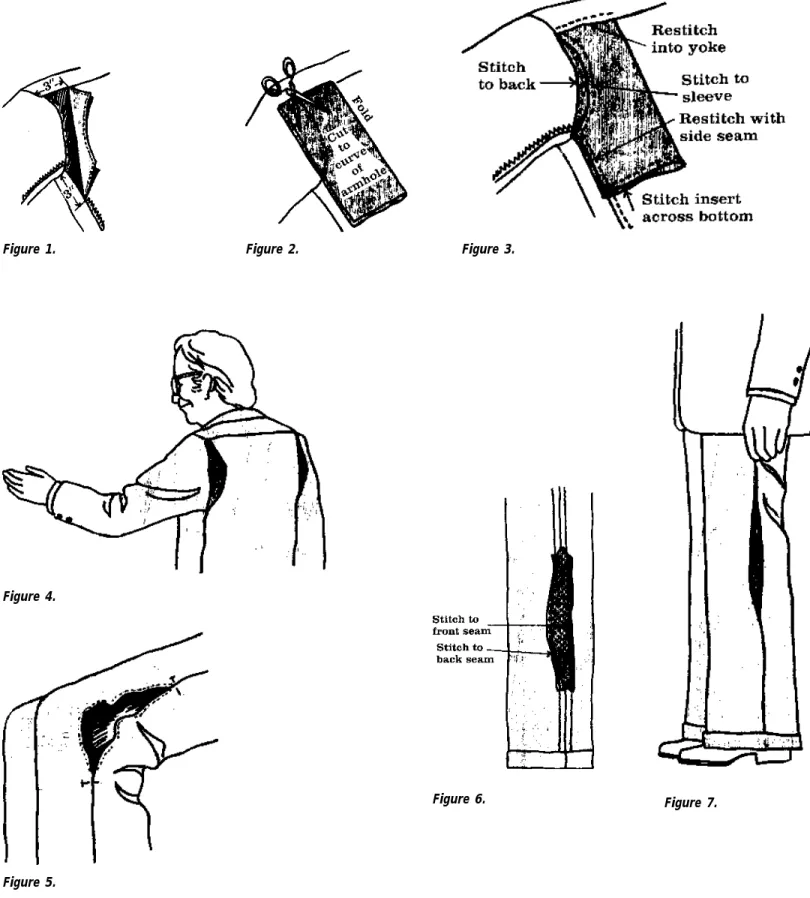CLOTHING
Colorado State University Cooperative Extension. 7/95.
C O N S U M E R S E R I E S
by K. Williams
1Shoulder Action Pleats
Action pleats can be put into the back or front shoulder areas of such clothes as jackets and coats as well as shirts and blouses.
A matching or near-matching piece of soft knit or woven fabric can be set in the armhole to provide more fabric space for reaching and moving without strain.
1. Open the armhole back seam up to the yoke or up to the shoulder seam, depending on the style of shirt. (See Figure 1.) Open up the yoke or shoulder seam for 3 inches. Open up the underarm side seam for 3 inches.
2. Using a matching fabric, cut out a fabric insert that matches the whole shoulder area—underarm armhole curve, and yoke or shoulder seam. Cut it double, on the fold. (See Figure 2.)
3. With right sides facing, sew the armhole sections of the fabric insert to the armhole seam allowance of the sleeve and the shirt back. (See Figure 3.) 4. Restitch the opened yoke or shoulder and underarm seams.
5. Edge finish raw edges to prevent raveling. 6. Press the pleat area into position. (Figure 4.)
Knee Action Pleats
A matching or near-matching fabric insert also can be sewn into the inside or outside of the knee area of slacks or pants. (See Figure 7.)
1. While the person is seated, mark the “kneebend” position on the slacks’ seams.
2. Open up the seam in the “knee” area for 9 inches to 10 inches. A strip of hem tape or twill tape may have to be stitched along each open seam edge because of narrow seam allowances. (See Figure 5.)
3. Cut a strip of matching or near matching medium-weight knit fabric or woven fabric on the bias. Cut it 2 inches longer than the knee opening and 1 3/4 to 2 inches wide.
4. With right sides facing, stitch the lengthwise sides of the fabric insert strip to the front and back leg seams of the slacks. (See Figure 6.)
Action pleats for greater comfort
no. 8.543
Quick Facts...
Action pleats allow more freedom of movement for the person wearing the garment. Action pleats can be put into the back or front shoulder areas of such clothes as jackets, coats, shirts or blouses.
A matching or near matching fabric insert also can be sewn into the inside or outside of the knee area of pants or slacks.
Issued in furtherance of Cooperative Extension work, Acts of May 8 and June 30, 1914, in cooperation with the U.S. Department of Agriculture, Milan A. Rewerts, Director of Cooperative Extension, Colorado State University, Fort Collins, Colorado. Cooperative Extension programs are available to all without discrimination. No endorsement of products is intended nor is criticism implied of products not mentioned.
1Reviewed by K. Williams, Colorado State
University Cooperative Extension apparel and textiles specialist, design merchandising and consumer sciences. Information from Michigan State University Bulletin E-1200, Action Pleats for Greater Comfort. Reprinted with permission.
Figure 1. Figure 2. Figure 3.
Figure 4.
Figure 5.
